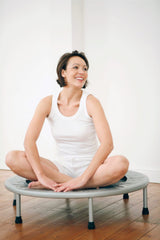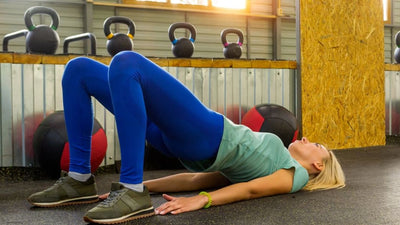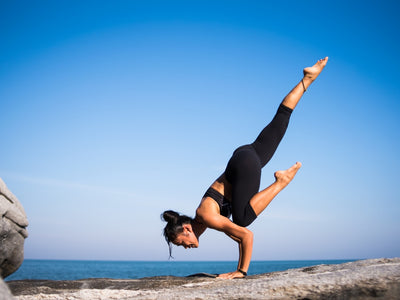Total-Body Trampoline Workout
Posted by Lara McGlashan on

Dr James preferred the rebounder for exercise and health. Here is why.
If you’re like most people, the last time you jumped on a trampoline was in grade school. But believe it or not, rebounding — the “technical” name for trampolining — has a host of benefits.
“Rebounding helps improve balance, coordination and proprioception,” says Fayth Caruso, ACE-CPT, instructor trainer for Pilates Academy International and education director for Bellicon USA. “It also strengthens the pelvic floor and core muscles while being gentle on the joints.” Here’s the 411 on this effective — and fun! — workout modality.
Jump ‘n’ Pump
Jumping up and down may seem lackluster at first glance, but this simple activity is actually quite complex on the cellular level: Your body and its trillions of cells accelerate away from the earth as you jump upward. You experience a moment of weightlessness at the apex of the jump, requiring everything to adjust as you change directions and are pulled back down by gravity. Then you and your trillions of cells suddenly decelerate as your feet hit the rebounder mat, then repeat that cycle when you once again go upward.
This kind of gravity-based, dynamic movement forces your cells, muscles, bones and other tissues to respond and adapt, and over time become stronger and more resilient. It also increases endurance at a cellular level by stimulating mitochondrial activity — thereby improving energy output — and builds bone density by increasing your “weight” as you decelerate into the rebounder.
Working outward from the cellular to the systematic, rebounding improves lymphatic circulation. “Think of the lymphatic drainage system as the metabolic trash can for the body, ridding you of toxic wastes,” says Krista Popowych, B.Hkin, 2014 IDEA Fitness Instructor of the Year and JumpSport program director. “This system doesn’t have a pump like the heart, so it relies on movement and muscle contraction for transportation.” Bouncing up and down forces the lymph upward through a system of one-way valves, which run vertically through your body (feet to head), helping boost immunity and detoxifying your system.
Bounce Away Body Fat
Moving to your physical exterior, rebounding is an effective way to build lean mass while also burning fat: A study published in the International Journal of Sports Science concluded that rebounding was twice as effective at improving aerobic fitness and 50 percent more efficient at burning fat than running on a treadmill. “And because of the reduced impact on bones and joints, you can sustain a longer workout session, allowing the body to burn more calories and resulting in extensive fat los,” says Jenny Belcher, PT Level 3, group fitness instructor, and CEO and founder of Boogie Bounce.
And when it comes to putting that physical exterior to good use, rebounding proves a remarkable performance booster and injury deterrent. “If you are on a bike or running, you move through the same repetitive movement in the same plane over and over again,” Caruso says. “Because the rebounding surface is a circle, you can literally move in every direction, improving agility and working all your muscles equally to prevent injury.”
So go ahead and jump! Science has hereby given you permission to make exercise fun again.
Bouncing Basics
Use these expert tips to improve your form — and your results — by leaps and bounds.
- Keep your feet parallel and distribute your weight evenly between them — side to side and forward to back.
- As you jump, push your heels into the mat for greater surface contact and to prevent your calf muscles from shortening.
- Keep your knees slightly bent and soft as you jump to act as shock absorbers.
- Engage your core to keep your pelvis neutral and avoid overarching or tucking.
- Keep your chest and chin lifted and look forward; looking down can throw off your balance and negatively impact your posture.
- Allow your arms to hang at your sides or integrate them into your workout to burn more calories and engage more muscles.
On-the-Rebound Workouts
Do each of these workouts one to two times a week. Warm up with some simple bouncing in place, starting low and getting higher as you heat up, moving your arms in all directions.

Jumping Jack
Stand in the center of the mat with your feet together, arms at your sides. Jump your feet out to the edges of the mat as you raise your arms overhead, then jump back to the center.

X-Jump
Jump down with force, feet together, arms at your sides. As you come into the air, open your legs and arms out into an X-shape, then quickly bring them back together to land for the next jump.
Low Squatting Jump
Stand with your feet on the outer edges of the mat and kick your hips back and bend your knees to lower into a squat, arms in front of you for balance. Stay low as you jump, raising your knees to hip height as you bounce while keeping your upper body steady.
Tuck Jump
Jump down with force, feet together, arms at your sides. As you come into the air, quickly bring your knees up to your chest as high as you can, then quickly extend your legs to land and go into the next rep.
Ski Jump
Stand to one side of the mat with your feet together, arms bent in front of you. Leap laterally side to side, keeping your knees and hips bent and your feet and legs together.
Knee Drive
Stand to the side of the rebounder, place your right foot on the mat and draw your right arm back. Quickly extend your right leg and drive up explosively as you bring your left knee up in front of you and swing your left arm forward, leaping as high as you can. Land softly on your right foot and absorb the impact as you return to the start. Do all reps on one side and then switch.
One-Legged Arabesque Leap
Face the rebounder with your arms at your sides. Using your right foot, drive down into the mat with force as you lift your left leg behind you, spread your arms to the sides and leap into the air, right leg straight. Land softly to absorb impact and repeat. Do all reps on one side and then switch.
Pistol Squat
Stand in the center of the mat on your left foot and extend your right leg straight out in front of you. Keep this leg straight as you slowly bend your left knee and drop your glutes toward the mat. Go as low as you can, then extend your leg and return to standing. Continue, alternating sides.
One-Legged Balance
Stand facing the rebounder and then place your right foot in the center of the mat, extending your arms to the sides. Slowly straighten your right leg and find your balance as you lift your left leg behind you as high as you can, aiming for parallel, keeping your head and spine neutral. Hold for time.
Side Plank
Place your right hand in the center of the trampoline and extend your legs to the side so your head, hips and heels align. Brace your core and find your balance as you extend your left arm toward the sky and lift your left leg (if you can). Hold for time.
Written by Lara McGlashan for Oxygen Magazine and legally licensed through the Matcha publisher network. Please direct all licensing questions to legal@getmatcha.com.

![[Podcast] Bladney and why use it.](http://www.drugfreehelpstore.com/cdn/shop/articles/Herbs_that_Heal_Bladney_d75b6c16-dca2-42e7-8e70-54ed8340ae13_400x.jpg?v=1586897182)
![[Podcast] The Benefits of Sodium Bicarbonate (Baking Soda)](http://www.drugfreehelpstore.com/cdn/shop/articles/TROHT_1-2-2020_97a2e574-97f3-49df-b1aa-91e08b85f113_400x.jpg?v=1586897177)

![[Podcast] Habits that mess up your kidneys](http://www.drugfreehelpstore.com/cdn/shop/articles/kidney_habits_400x.jpg?v=1462324429)
![[Podcast] Water Water everywhere, are you getting enough?](http://www.drugfreehelpstore.com/cdn/shop/articles/Water_podcast_cover_400x.png?v=1474659787)


